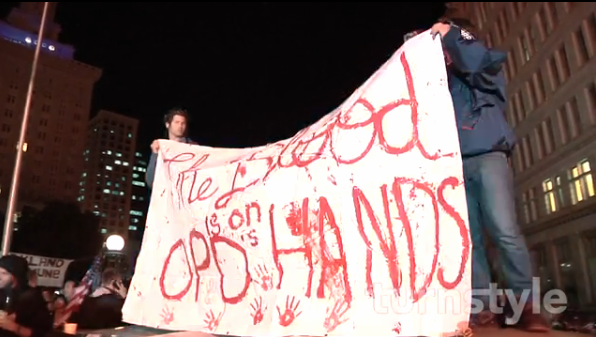By: Sayre Quevedo

Is there a place for violence in the Occupy movement?
Just hours after Oakland police disbanded the Occupy Oakland camp on Monday, hundreds of protesters gathered on the steps of the main branch of the public library to plot their next move. In what's become a staple of the occupy movement, they held a General Assembly meeting as they had for weeks prior to their eviction from Frank Ogawa Plaza.
The large crowd at Monday's assembly used the human mic to communicate, a tactic first used by Occupy Wall Street protesters in New York's Zuccotti Park to sidestep laws against using amplifiers.
At one point a man stood and asked, "Why has there been no official position of non-violence?" The question fell like a drop of water, spreading in rings throughout the crowd.
"Why has there been no official position of non-violence?"
"Why has there been no official position of non-violence?"
Twice the question was repeated by the crowd before the man spoke again. "In the fight against tyranny, it's time to draw the line," he said, "To fight violence with non-violence." The crowd erupted in cheers, but immediately someone stood to offer a different position, "I think the debate about what constitutes violence and what constitutes non-violence will have to wait," the man said, "I myself will not tell people they are wrong or right for what I believe."
This issue is at the heart of conversations happening among protesters throughout the nation. Is there a place for violence in the Occupy movement?
Scott Campbell is a central figure within Occupy Oakland, and prominent voice on social media regularly tweeting from the handle AngryWhiteKid. He says there's not a simple answer to the question, "To say, we're a nonviolent movement. Well, what does that mean? As we saw the other day with Occupy Cal, the chancellor of UC Berkeley said that linking arms was a form of violent protest."
Campbell is also well known for a video he made showing a phalanx of riot-clad officers in downtown Oakland. At the beginning of the video (below), Campbell can be heard repeatedly asking, "Is this okay?" Then, seemingly without provocation, he's shot by a beanbag round.
The video has garnered more than 700,000 views and furthered debate about the use of force by law enforcement. Campbell has filed suit against police for the shooting, and says violent tactics employed by police have led protesters to consider increasingly aggressive tactics themselves. "A movement is successful when it doesn't limit itself to one way, and only one way of doing things," says Campbell.
A self-described anarchist, Campbell says scrutiny about anarchists elevating the level of violence is misplaced. "Without the participation of anarchists I don't think Occupy Oakland would have happened, and I don't think that it would have had the strength that it does. And you can see in general the occupy movements are very much informed by anarchists principles, and tactics, and ways of organizing that I think go unrecognized."
General Assemblies are a common tool among anarchists, designed to achieve direct and open democracy, and committees within the Occupy Movement, such as safety, food, and event planning, are leaderless. Also the idea of employing broad array of tactics is a philosophy that draws inspiration from anarchist ideology. But violence, a tactic often referred to as Blac Bloc Anarchy, remains a divisive topic.
Randy Mejivar, an Oakland resident and Occupy Oakland protester, was one of hundreds who stood in the crowd outside the Oakland library Monday night. He says he firmly believes the movement needs to take a strict non-violent approach. "There's no structure to be able to filter [them] out," says Mejivar. "They embrace everybody based on good intentions here and they're not able to distinguish who's on what side."
Nearby fellow protester Micha Steimer disagreed. "You can't exclude groups who want to come and join a protest. The minute you do that you don't have a protest. But I think that it's unfortunate that there are violent elements of the occupy movement and I wish they weren't there but that doesn't mean I don't understand where they're coming from."
Zoe De Salle doesn't expect consensus around the use violence anytime soon. La Salle, who helped organized the original Occupy Oakland camp at Frank Ogawa Plaza, says, "People don't want to close the conversation. [They] think that any sort of resolution would be an end to the conversation about what types of tactics we want, and what kind of tactics are good, and what is violence and what is non-violence. And we're not going to come to a resolution soon because we need to have that conversation for quite a while."
Protesters like De Salle and Campbell are quick to argue that while the Occupy camp here in Oakland is gone, the movement is only growing, here and throughout the country. And they say this debate about tactics and methods, and whether there's a place for violence within Occupy, is a conversation that is ever evolving.
Originally published on Turnstylenews.com, a digital information service surfacing emerging stories in news, entertainment, art and culture; powered by award-winning journalists.